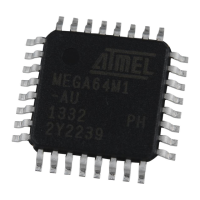9
7647H–AVR–03/12
Atmel ATmega16/32/64/M1/C1
The ATmega16/32/64/M1/C1 provides the following features: 16K/32K/64K bytes of In-System
Programmable Flash with Read-While-Write capabilities, 512/1024/2048 bytes EEPROM,
1024/2048/4096 bytes SRAM, 27 general purpose I/O lines, 32 general purpose working regis-
ters, one Motor Power Stage Controller, two flexible Timer/Counters with compare modes and
PWM, one UART with HW LIN, an 11-channel 10-bit ADC with two differential input stages with
programmable gain, a 10-bit DAC, a programmable Watchdog Timer with Internal Individual
Oscillator, an SPI serial port, an On-chip Debug system and four software selectable power sav-
ing modes.
The Idle mode stops the CPU while allowing the SRAM, Timer/Counters, SPI ports, CAN,
LIN/UART and interrupt system to continue functioning. The Power-down mode saves the regis-
ter contents but freezes the Oscillator, disabling all other chip functions until the next interrupt or
Hardware Reset. The ADC Noise Reduction mode stops the CPU and all I/O modules except
ADC, to minimize switching noise during ADC conversions. In Standby mode, the Crystal/Reso-
nator Oscillator is running while the rest of the device is sleeping. This allows very fast start-up
combined with low power consumption.
The device is manufactured using Atmel’s high-density nonvolatile memory technology. The
On-chip ISP Flash allows the program memory to be reprogrammed in-system through an SPI
serial interface, by a conventional nonvolatile memory programmer, or by an On-chip Boot pro-
gram running on the AVR core. The boot program can use any interface to download the
application program in the application Flash memory. Software in the Boot Flash section will
continue to run while the Application Flash section is updated, providing true Read-While-Write
operation. By combining an 8-bit RISC CPU with In-System Self-Programmable Flash on a
monolithic chip, the Atmel ATmega16/32/64/M1/C1 is a powerful microcontroller that provides a
highly flexible and cost effective solution to many embedded control applications.
The ATmega16/32/64/M1/C1 AVR is supported with a full suite of program and system develop-
ment tools including: C compilers, macro assemblers, program debugger/simulators, in-circuit
emulators, and evaluation kits.
2.2 Automotive Quality Grade
The ATmega16/32/64/M1/C1 have been developed and manufactured according to the most
stringent requirements of the international standard ISO-TS-16949. This data sheet contains
limit values extracted from the results of extensive characterization (Temperature and Voltage).
The quality and reliability of the ATmega16/32/64/M1/C1 have been verified during regular prod-
uct qualification as per AEC-Q100 grade 1.
As indicated in the ordering information paragraph, the products are available in only one tem-
perature grade.
Table 2-1. Temperature Grade Identification for Automotive Products
Temperature Temperature Identifier Comments
-40 ; +125 Z Full AutomotiveTemperature Range

